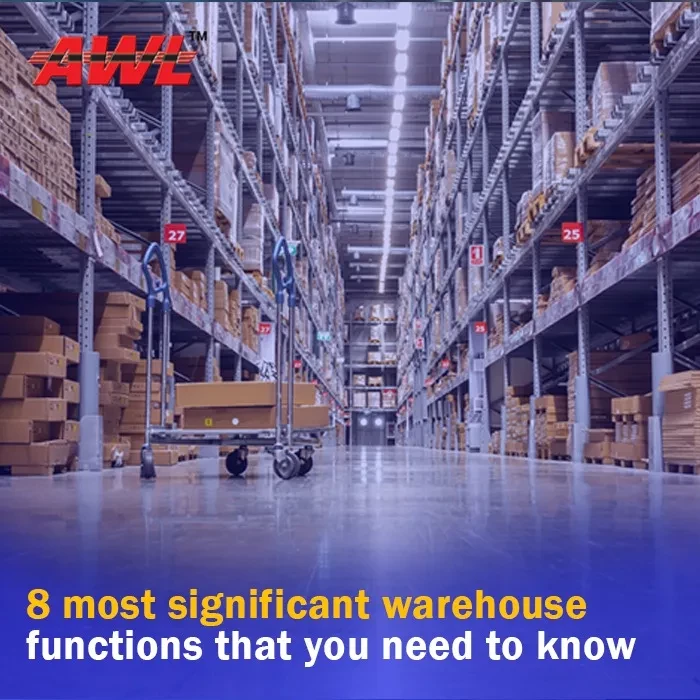
02-May-2023

In today’s time warehouses are used by almost every enterprise including manufacturers, wholesalers, exporters, and importers. Warehouses are needed in a variety of businesses, including transportation and customs. A warehouse is a location dedicated to the efficient storage of commodities and supplies. In its most basic form, is a facility used to store commodities. In reality, though, it is far more than that. While this work may appear insignificant in comparison to other business process segments, it is critical to recognise that it is a dynamic operation that, when used effectively, can generate a lucrative return on investment. AWL Warehouse is one of the most technologically advanced warehouses in the country. These warehouses are outfitted with smart warehouse technology, which may increase the efficiency of warehousing operations, making AWL India one of the leading warehouse service providers in India.
The following are the top eight warehouse functions that everyone should be aware of:
The fundamental role of any warehouse is to secure the items and assure the inventory's total safety from any potential hazards or threats. A warehouse safeguards objects against loss, theft, or damage due to adverse weather conditions such as heat, wind, dust, and humidity, among others. A warehouse can make special arrangements for different commodities based on their qualities. It can, for example, engage security guards to deter theft, establish a cold storage facility for perishable commodities, apply pesticides to preserve them, and construct fire-fighting equipment to deter fires. If all of these circumstances are carefully examined and handled, a warehouse may be able to significantly minimise losses due to item degradation and wastage during storage.
The primary function of a warehouse is to provide storage space for equipment, stocks, or other goods. It provides ideal storage facilities for firms when their products are not required for sale. This decreases stock waste while simultaneously preserving and protecting it. Such commodities may be kept until they are utilised or consumed, regardless of when they are made or acquired. Furthermore, during the holiday season, the demand for confectionary goods skyrockets, necessitating more storage space. As a result, it is critical to forecast market trends and demand and organise storage accordingly.
Extra stock, on the other hand, must be kept in order to fulfil the anticipated increased demand for the product as a consequence of promotional efforts such as sales promotion. Speculative purchases are another important factor to consider. Goods are frequently purchased in bulk due to future pricing projections that are lower or higher. This needs the construction of more storage space. As a consequence, a warehouse's storage function aids in the efficient running of the firm while simultaneously dealing with a variety of unusual events.
The transportation of commodities may be divided into four primary kinds, which are as follows:
Inbound activity: Unloading of products received by the warehouse is an example of inbound activity.
Transfer to storage: This is the process of moving products from the inflow area to the storage area.
Order selection: It entails picking the item in storage that corresponds to the order to be dispatched and moving it to the shipment area.
Outbound activity: Finally, 'outbound activity' refers to examining and loading products for shipment.
To ensure continuous ordering, the movement of commodities across a warehouse must be as smooth as feasible. As a result, the warehouse's infrastructure, as well as the software systems it utilises, must be updated on a regular basis.
One of the numerous functions of a warehouse is finance. Warehouse finance is a type of inventory financing in which a bank lends money to a manufacturer, company, or processor. In this case, goods, stocks, or commodities are stored in a warehouse and used as collateral for the loan. When things are relocated to a warehouse, the depositor is given a receipt as confirmation of the deposit. A 'Warehouse-warrant' is a certificate issued by the warehouse in favour of the owner of the products. keeper's This is a title document that may be passed on with simple approval and delivery. As a result, while the products are in the warehouse's custody, the owner can get loans from banks and other financial institutions by pledging this warrant as collateral.
Warehouses would sometimes issue short-term cash loans to depositors while holding their merchandise as security. Borrowers benefit from warehouse financing in a variety of ways. A fundamental feature of warehouse financing is the ability of borrowers to utilise their raw materials, commodities, and other assets as collateral for the loan. Warehouse finance typically provides borrowers with a better choice for financing than unsecured loans or short-term working capital. Furthermore, warehouse financing terms are rather flexible and frequently advantageous to the borrower, small businesses, and manufacturers who rely on this type of credit. It is typically less expensive than other types of borrowing since it is secured.
Warehouses keep track of the things and commodities that are received, stored, and sent out. Any additional information regarding the institution is also noted. It allows warehouse managers and other interested parties to acquire exact information on stock availability, stock processing, and stock replenishment needs. The warehouse's information system must keep accurate, timely, and error-free data. It might then be sent to senior management so that they can make more informed and better decisions.
Warehouses play a key role in pricing stability. They help to regulate price fluctuations via -
When there is an excess of demand in the market, the increased flood of items may drop their price even further, resulting in losses for business owners. As a result, warehouses maintain the stock in this case until demand for such things grows again. This is how warehouses provide a steady supply of market commodities by matching supply and demand, hence stabilising prices.
A value-added service is anything that goes above and beyond typical warehousing. Such services contribute to the optimisation of supply chain management, the creation of added value, and the efficient delivery of commodities to customers. Examples include bundling, customisation, re-branding, re-packaging, processing, and so on. Several of these are discussed further below:
Processing: This is the process through which some foods are rendered edible. Timber seasoning, fruit ripening, coffee bean processing, paddy polishing, and so on are examples. Warehouses will occasionally do such activities on behalf of their owners.
Grading and Branding: Warehouses also grade and brand commodities on behalf of the distributor, importer, or manufacturer of the goods. They also provide mixing, blending, co-packing, and repacking.
Product Customization: Customization services provided by warehouses enable the construction of bundles or bespoke items to match the demands of each customer or market (for example, bundling, SKU building, localization, product boxing, or kitting).
Other Services: A warehouse can also provide value-added services including labelling, stamping, gift wrapping, barcode printing, order fulfilment and invoice printing, quality control, insurance, and product disposal.
The provision of such services at the warehouse relieves the organisation employing it of a considerable load and allows it to focus on its principal activity. As a result, costs are decreased and standards are enhanced.
Aside from the tasks listed above, warehouses can also perform the following:
Risk Bearing: When goods are given for storage, the warehouse-keeper accepts responsibility for them. As a result, the warehouse keeper carries the risk of goods loss or damage. Because it is now the warehouse's responsibility to return the products in good condition, it is liable for any mishaps. As a result, every precaution is made to avoid a situation like this. The items that are retained may also be insured for loss compensation.
Rental property: Some warehouses may earn rental money for their owners by renting them out to people or businesses who need storage or other services.
Warehouses are typically located in convenient places, such as near a road, airport, train, or river, to facilitate product movement.
These are the eight most important warehouse functions that you should be aware of. Furthermore, by analysing these functions, it is reasonable to conclude that a warehouse is far more important to a company's success than most people realise. AWL India is one of the top warehouse logistics firms in India, offering cutting-edge smart warehouse solutions as well as cold chain warehouse. AWL India thinks that appropriate monitoring of these procedures is necessary to maintain the seamless running of all warehouse activities.